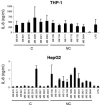Differential inlA and inlB expression and interaction with human intestinal and liver cells by Listeria monocytogenes strains of different origins
- PMID: 16751490
- PMCID: PMC1489604
- DOI: 10.1128/AEM.02164-05
Differential inlA and inlB expression and interaction with human intestinal and liver cells by Listeria monocytogenes strains of different origins
Abstract
In this study, a number of Listeria monocytogenes strains of different origins were evaluated for in vitro invasion capacity for various human cell types (monocytic THP-1, enterocytic Caco-2, and hepatocytic HepG2 cells) and for expression levels of specific virulence genes. For THP-1 cells, no differences between clinical and nonclinical L. monocytogenes strains in invasion capacity or in production of the proinflammatory cytokine interleukin-8 (IL-8) were observed, whereas for the Caco-2 and HepG2 cells, significant differences in invasion capacity were noticed. On average, the clinical strains showed a significantly lower invasion capacity than the nonclinical L. monocytogenes strains. Furthermore, it was shown that the clinical strains induce lower IL-8 levels in HepG2 cells than do the nonclinical strains. This observation led us to study the mRNA expression levels of inlA, inlB, and ami, important virulence genes mediating adhesion and invasion of eukaryotic cells, by real-time reverse transcription-PCR for 27 clinical and 37 nonclinical L. monocytogenes strains. Significant differences in inlA and inlB expression were observed, with clinical strains showing a lower expression level than nonclinical strains. These observations were in accordance with in vitro invasion of Caco-2 and HepG2 cells, respectively. The results of this study indicate that differential expression levels of inlA and inlB possibly play a role in the virulence capacities of L. monocytogenes strains. The lower capacity of clinical strains to invade HepG2 cells and to induce IL-8 is possibly a mechanism of immune evasion used by specific L. monocytogenes strains.
Figures



References
-
- Braun, L., S. Dramsi, P. Dehoux, H. Bierne, G. Lindahl, and P. Cossart. 1997. InlB: an invasion protein of Listeria monocytogenes with a novel type of surface association. Mol. Microbiol. 25:285-294. - PubMed
-
- Brosch, R., B. Catimel, G. Milon, C. Buchrieser, E. Vindel, and J. Rocourt. 1993. Virulence heterogeneity of Listeria monocytogenes strains from various sources (food, human, animal) in immunocompetent mice and its association with typing characteristics. J. Food Prot. 56:296-301. - PubMed
Publication types
MeSH terms
Substances
Associated data
- Actions
- Actions
- Actions
- Actions
- Actions
- Actions
- Actions
- Actions
- Actions
- Actions
- Actions
- Actions
- Actions
- Actions
- Actions
- Actions
- Actions
- Actions
- Actions
- Actions
- Actions
- Actions
- Actions
- Actions
- Actions
- Actions
- Actions
- Actions
- Actions
- Actions
- Actions
- Actions
- Actions
- Actions
- Actions
- Actions
- Actions
- Actions
- Actions
- Actions
- Actions
- Actions
LinkOut - more resources
Full Text Sources

